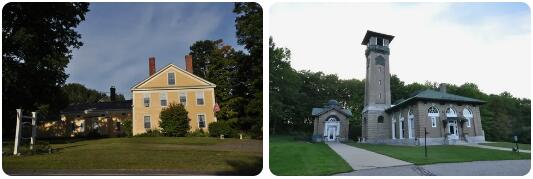
Androscoggin County is a county located in the state of Maine, in the United States. It is part of the Lewiston-Auburn, ME Metropolitan Statistical Area and is made up of 7 towns and 11 cities.
The county’s population was 107,702 as of 2019 and its county seat is Auburn. The county is named for the Androscoggin River which runs through it.
The land that makes up Androscoggin County was originally inhabited by Native Americans before being settled by Europeans in the 17th century. The area was first incorporated as part of Cumberland County in 1760 and became part of Lincoln County in 1803 before finally becoming its own county in 1854.
Androscoggin County has a total area of 593 square miles, making it the second smallest county in Maine. There are several rivers that run through it including the Androscoggin River, Little Androscoggin River, Sabattus River, and Dead River. The highest point in the county is Bald Pate Mountain at 1,741 feet above sea level while the lowest point is at sea level along its coastline on Casco Bay.
The climate here is typical for New England with cold winters and mild summers. Average temperatures range from lows around 0°F to highs around 80°F throughout the year with precipitation levels averaging around 43 inches annually.
Agriculture plays an important role in Androscoggin’s economy with dairy farming being one of its primary industries. Other important industries include paper mills (the largest employer), tourism and retail trade, manufacturing (including textiles), health care services, education services, construction and utilities (electricity).
There are several higher educational institutions located here including Bates College (a liberal arts college), University of Southern Maine (USM) Lewiston-Auburn Campus (a public university) and Central Maine Community College (CMCC). These schools offer students a variety of degree programs ranging from certificate programs to doctoral degrees making them some popular choices for those looking to further their education or gain new skillsets.
Androscoggin also offers many recreational activities for visitors and locals alike such as fishing on one of its many rivers or lakes; hiking or biking on trails like Rangeley Lakes National Scenic Byway; camping at one of its many campgrounds; exploring historic sites like Fort Halifax Park or Fryeburg Fairgrounds; visiting museums such as Maine Mineral & Gem Museum or Maine State Museum; golfing at one of its many courses; visiting art galleries like Bates College Museum Of Art; or simply enjoying nature’s beauty at places like Bradbury Mountain State Park or Sebago Lake State Park among many others!
Androscoggin County provides something for everyone – whether you’re looking to pursue higher education opportunities, find employment opportunities within various industries or just enjoy some outdoor activities – this charming place has it all.
History of Androscoggin County, Maine
Androscoggin County, Maine is located in the south central part of the state and borders the states of New Hampshire and Massachusetts. The county was named after the Androscoggin River, which flows through it.
The history of Androscoggin County can be traced back to 1607 when English explorer George Weymouth explored its shores. During this time, it was inhabited by the Abenaki Native American tribe who lived in what is now known as Turner, Maine.
In 1642, Androscoggin County was part of a grant from Massachusetts Bay Colony to William Gorges. This grant included much of what is now known as Maine’s mid-coast region. In 1760, Massachusetts General Court established what would become Androscoggin County as a separate political entity from Cumberland County.
In 1791, Androscoggin County began to grow with settlers coming from nearby states such as Vermont and New Hampshire to take advantage of its abundant natural resources. These settlers built homes and businesses along the banks of rivers such as the Androscoggin and Kennebec Rivers which provided transportation routes for goods and services throughout the region. In addition to this, they established farming operations on land that had been cleared for agriculture purposes such as wheat, corn, hay and potatoes among other things.
During this period in history, Androscoggin County also became an important center for industry due to its access to water power from rivers like the Androscoggin River which allowed factories such as paper mills and textile mills to be built along its banks. The county also played an important role in Maine’s lumber industry by providing wood for shipbuilding operations throughout coastal Maine towns such as Bath and Brunswick.
By 1820s, Androscoggin County had become one of Maine’s most populous counties with more than 20 thousand people living there at that time. This population explosion led to rapid growth in industries such as paper manufacturing where local companies began producing large amounts of paper products for both domestic use and export abroad.
Today, Androscoggin County remains an important center for industry in Maine with many large corporations based here including St Mary’s Regional Medical Center which is one of the largest employers in the region employing more than 2 thousand people annually while other notable employers include Sappi Fine Paper North America Inc., Huhtamaki Americas Inc., Unum Group Inc., Central Maine Power Co., Georgia Pacific Corp., Verso Corp., Sappi Fine Paper North America Inc., Huhtamaki Americas Inc., Unum Group Inc., Central Maine Power Co., Georgia Pacific Corp., Verso Corp.. In addition to this it is also home to several colleges including Bates College located in Lewiston-Auburn metropolitan area which has been ranked among top liberal arts colleges in United States by US News & World Report magazine since.